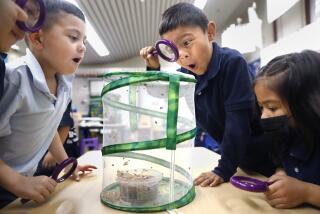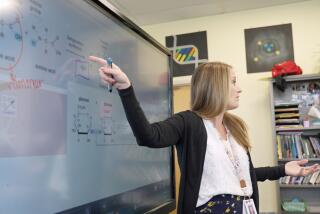Essay, Exam, Materials With Heart Mark Fresh Approaches in Schools : Health Education Gets New Look
- Share via
A creative, hands-on approach to teach children how to have a healthier heart through diet and exercise is now available to elementary schools, both in San Diego and statewide, from the American Heart Assn.
But years of neglect by school districts toward health and physical education make it questionable whether the materials will be quickly disseminated.
The curriculum features jazzy videos, games, music, books and work sheets designed to bring alive a subject often dismissed as boring by teachers as well as students. There are separate kits for kindergarten, grades 1-3 and grades 4-6. The materials focus on the heart, food and hygiene, and talk about peer pressure against healthy endeavors.
The upper-grade video about the heart--and how to take care of it--features aliens who land on Earth during a rock concert and shows what their examination of the lead singer’s cardiovascular system reveals.
‘Never Start Early Enough’
“You can never start early enough with this kind of health education,” Alan Richmond, coordinator of physical and health education for the San Diego Unified School District, said Monday. “We know that students at an early age can start to develop bad habits, but hopefully students now will start to learn heart-healthy behaviors that can carry through to adult life.”
Although San Diego Unified--the nation’s eighth-largest system--provides health textbooks for several nine-week units at each elementary grade level, there is not always strong emphasis by district administrators or principals.
The district has only one curriculum specialist in physical and health education to work with teachers for its 116,000 students in 180 schools, a situation that Richmond acknowledges is pathetic. And few if any teachers receive instruction in health matters during their required year of specialized teacher education.
The state Department of Education is gearing up to change the situation by creating statewide physical and health education testing for students. But Richmond said he still must depend on individual schools to take interest in using supplementary materials such as the heart association kits. So far, only about 250 teachers reaching 4,000 students are using the heart program in San Diego County, out of a potential of more than 10,000 teachers and a quarter-million students, since all three kits became available in late spring.
Heart Assn. program coordinator Diane Larrabee said Monday that volunteers will visit schools and show teachers in a one- to two-hour presentation how to use the kits. The kits, valued at about $500, are given free to participating schools.
Richmond said many teachers already understand the connection between good health and increased learning, but most have not yet pushed for stronger school health and physical education programs. Only a handful of elementary schools--Grant, Green, Fulton, Zamorano and Dewey--have added regular health and physical education programs to their curriculums.
“These things really go by word of mouth,” Richmond said. “It’s important to get the word out about the philosophy of eating the right type of foods, knowing why exercise is important and in general learning how to make appropriate choices.”
More to Read
Sign up for Essential California
The most important California stories and recommendations in your inbox every morning.
You may occasionally receive promotional content from the Los Angeles Times.













